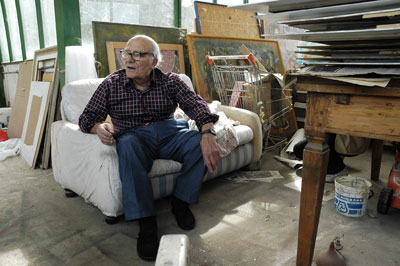23th > 25th september 2007
Prato, Offiicina Giovani
Crossing a territory, living it and making it one’s own is an experience which changes the traditional role of the spectator-witness towards his/her radical human and personal involvment. The way one looks at himself/herself gets in this case changed. This is probably the experience which mostly left a trace on the participants to the workshop held by Mario Rizzi in the city of Prato during the first workshop of Networking 2007. Being a witness and taking part to a specific social reality forces to re-read the latter and oneself through new eyes.
After a short presentation which enabled the participants to tell their work and path, during the first meeting of the workshop a lot of time was spent for an exchange of ideas, trying to identify the interests of the group and the themes on which to work. The theme on which the workshop was based was one of the seven places of contemporary conflict at the base of the whole course of Networking 2007. In particular the idea of “identity” as place under construction at the core of representations and processes often ajar and paired. Different places in fact, to be investigated, probed and built. Places which right from the start became the focus of the initial discussion. How to understand the identity of the city of Prato? Can it be told through a single all-embracing form? Or is this identity made by a manifold sum of differences? The investigation started from this discussion immediately moved into the city, face to face with its inhabitants, the contradictions, the conflicts.
The work moved like this from the space disposed for the manifestation to the streets, the shops, the factories and the houses of the city. What emerged in all their semantic strength were the places of the wholesale clothing trade, the so called “Chinese pronto moda”. Here this industrial and commercial suburb of the city has become in few years an important centre at European level for the sale of clothing pieces to wholesale dealer, above all to sellers of markets. The clothing items, above all manufactured in Prato by workers with Chinese passport, tell well the continuation of the journey started in China through dresses perfectly integrated with the last European fashion, but often with small sizes which probably tell the bodies on which they have been cut. From this first contradictory identity, Confezione-identitàwas born. The fashion show work presented during the opening of the workshop. |
It was a parade of the clothes borrowed by the pronto moda, presented by a twenty-year old Chinese girl through a video background which told the course covered by the participants to look for the dresses. From a parallel course also the work Do you want to become Chinese? Here it is how you canwas arisen. This latter one is focused on the image which the Chinese teenagers of the city try to convey of themselves outside. This work consisted in a collection of inteviews and of iconographic material (posters, magazines, newspapers) carried out by the participants around the city’s streets. The work was completed with the presentation of a guide to become Chinese (one guide “for him” and one “for her”) written on the hints of the interviewed teenagers; it includes the way of dressing up, of behaving, of entertaining social relationships and of making up. The effects of such a guide became visible in the test that the authors of the work experimented on themselves during the opening. Also Kertenkele dealt with identity under construction and hanging in the balance among different origins; an intimate confession, a dialogue among three girls, a Turkish, an Italian and an Austrian one.
The three female authors met around the dinner table of one of them and confronted themselves with each other on every thing that some young women can talk about: sex, family, future, politics… The camera of the female authors overturned this time, and precisely on their own most intimate and personal aspects, not to do a personal account and a celebration of their ego, rather to record inside themselves systemic cracks and that underlying likeness which the other always brings with himself/herself.
The last work produced, by the four operative subgroups of the workshop, was Burilli’s house. The city’s identity was this time declined in the human and professional story of a eighty-year-old painter who tied his whole personal story to the city of Prato. The participants went to the painter’s workplace and requested him to have the chance to organize and look after an exhibition of his works within the final exhibition. The meeting-exchange was then realized through an audio interview, the photographic narration of the path and through the portrait of a female participant to the workshop which the painter wanted to realize. A way for the young artists to look at themselves through different eyes and to look at the city and at their work as a whole indissolubly linked.
text published on Tafter.it on October 19, 2007. |





